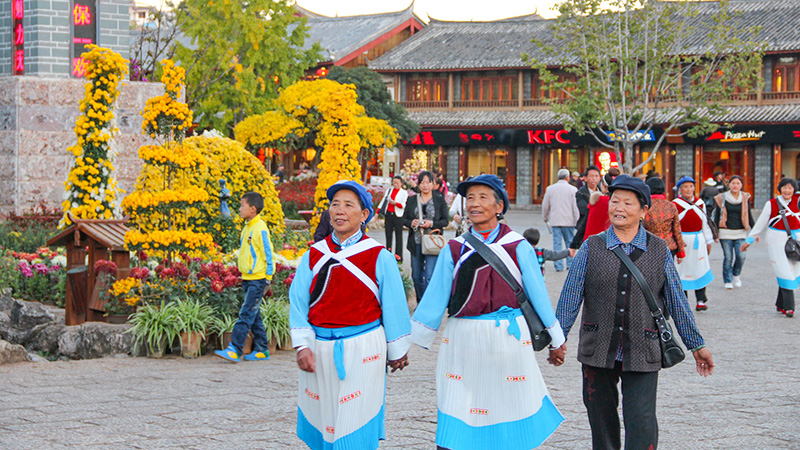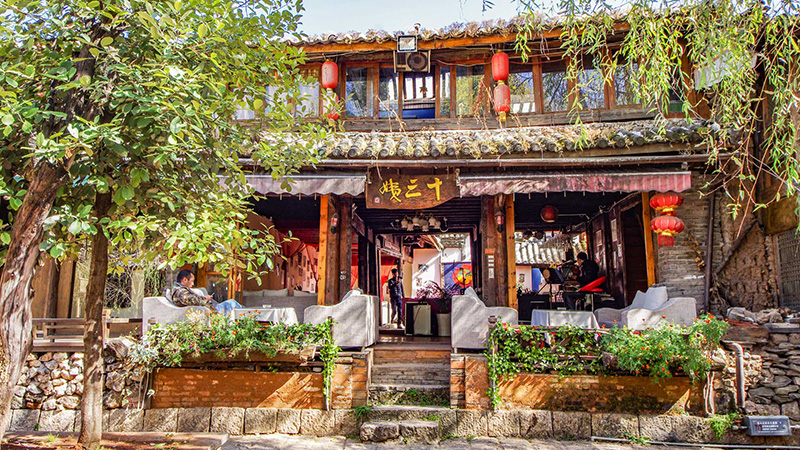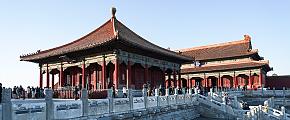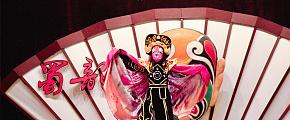Lijiang - Step Back in Time
Old Town
The Old Town of Lijiang is a world-famous tourist destination. It is a well-preserved ancient city filled with ethnic minorities, culture, and art. Old Town was originally founded in the late Song (960-1279) and Early Yuan (1279-1368) Dynasties. Lijiang's Old Town occupies an area of over 8 square kilometers. It is backed by the tree-covered Lion Mountain in the west, Elephant and Golden Row Mountains in the north, and fertile fields in the Southeast. The unique geographical location, history, and ethnic minority residents make Lijiang's Old Town a most special one. The Old Town of Lijiang was put on the list of the World's Relics by the World Cultural Heritage Commission of UNESCO.
The architectural styles of the buildings in Old Town are of great interest to visitors. They incorporate architectural traits of the Naxi, Bai, Tibet, and Han ethnic groups. The houses are placed close together and the lanes are narrow. The houses are mostly earth, tile, and timber structures, each featuring its own garden courtyard. The Naxi people take great pride in the decorations applied to their houses. Doors and windows feature vivid carvings of people, animals, and auspicious symbols.
The Old Town depends on water for its existence. The main water source for the town is the Black Dragon Pool. It splits into many canals which can be reached by every street in the town. The town features almost 350 bridges and willow trees grow everywhere due to the abundance of water. The old town is sometimes called "Oriental Venice."
The center of the Old Town and it is cultural focal point is Square Street. The town's four main streets radiate from it in the four cardinal directions. Countless lanes and alleyways extend in all directions. The streets are paved with the local Bluestone. They have been polished by centuries of feet and hooves but still look like they were recently laid. Late at night, a sluice gate in the center of the town is opened, and water rushes down the streets, washing the streets of town clean.
Old Town is a place that will not only capture your imagination but your heart. It is a magical place that time seems to have forgotten, filled with an amazing culture and warm people. It is a jewel in the crown of China that has remained unchanged for centuries.
 Ancient Town, Lijiang
Ancient Town, Lijiang
Consisting of 13 peaks Jade Dragon Snow Mountain is over 35 kilometers in length, with the highest peak Shanzidou, reaching an altitude of 5,600 meters. Looking up at Jade Dragon Snow Mountain from Old Town, the snow-covered mountain wrapped in mist resembles a jade dragon lying in the clouds.
There is a legend about the creation of Jade Dragon Snow Mountain. It is said that in ancient times there were two twins. They lived by panning gold in the Golden Sand River. One day an evil spirit took over the river. The brothers were very brave and decided to fight the spirit. One brother, Haba, died in the battle, and his brother, Jade Dragon, drove the evil spirit away, but in doing so, wore out 13 swords. For fear of the evil spirit's return, Jade Dragon held the 13 swords day and night to guard the people. As time passed, the two brothers turned into mountains, and the 13 swords of Jade Dragon became the 13 peaks on Jade Dragon Snow Mountain. For the local Naxi people, Jade Dragon Snow Mountain is a holy mountain not only for the legends but also because it became a place for young lovers to sacrifice themselves in honor of true love to escape from arranged marriages.
Jade Dragon Snow Mountain has become a famous scenic spot for mountaineering, skiing, sightseeing, and scientific research. It is an area rich in tradition, history, and natural beauty.
Lijiang Mural
In 15 temples ten kilometers northwest of Old Town are stored the Lijiang Mural. Originally the mural consisted of over 200 pieces, but after hundreds of years, only 55 are left in good condition. This famous fresco was created in the Ming (1368-1644) and Qing (1644-1911) Dynasties. The frescos are located in Baisha, Dayan, Shuhe, Yangxi, and Xuesong villages. The most famous frescos are known as the Baisha Mural of the Dbaoji (Great Treasure) Palace and the Colored Glaze Temple in the town of Baisha. During the Ming and Qing Dynasties, the Lijiang area was witnessing rapid economic and religious development; the Lijiang Mural was a representation of this progress.
The creators of these frescos came from different nations, including local Naxi Dongba painters, the Taoist painter Zhang from the central plains, Tibetan artist Guchang, Han artist Ma Xiaoxian, and Li Zeng, and many other artists whose names have been lost to history. What makes the Lijiang Murals different from other frescos is that they contain the artistic forms of Buddhism, Lamaism, Daoism, and the Naxi Dongba religion. Each painting contains over 100 characters, and perspective is used very well. The lifelike portraits not only portray religious symbolism, but also depict ordinary people such as bureaucrats, criminals, tourists, and executioners. The vivid facial features, flowing lines, well-defined colors, and exquisite details make the Lijiang Murals a rare art treasure, and an important source of information for research into ancient religions, art, and history.
Ancient houses
With a history of more than 800 years, the residences of Lijiang's Old Town represent a splendor not found in the modern world.
The two-story houses are always created from earth and timber. These ancient houses are usually created around an open courtyard, much like Beijing's quadrangle. All of these ancient houses are covered with rich ornamentation, which is usually emphasized on the windows, doors, and screen walls. The corridors and screen walls are usually decorated with marble, while the doors and windows are carved with various flowers, animals, and auspicious symbols. The pathways are paved with pebbles in different patterns. Each courtyard is used as a private garden where families take great pride in their rare and exotic flowers and plants.
These ancient houses give us a glimpse into a long-gone era, a time when a family's status and religious beliefs were carved directly into their houses. They come from a time that is gone but should not be forgotten.
 Ancient Town, Lijiang
Ancient Town, Lijiang
Bars and cafes
One of the highlights of a visit to Lijiang is its bars and cafes. Located in the old town, Xinhua Street is Lijiang's famous bar street. Here visitors from around the world come to enjoy Lijiang's nightlife. A large number of bars are owned and operated by Westerners, adding to the charm and diversity of the bar scene here.
Le Petit Paris:
Owned and operated by a French man and his Chinese wife, the romantic love story of this couple makes Le Petit Paris one of the most popular bars for visitors to Lijiang. Each night local Naxi maidens sing the traditional Naxi antiphonal singing style. Visitors are welcome to join in.
Location: No.111, Cuiwen Duan, Xinhua Jie, the Old Town, Lijiang
Sakura:
Opened in 1996, Sakura was opened by a Chinese man and his Korean wife. It is a bar and a Western restaurant. It is also one of Lijiang's most popular nightspots.
Location: No.123, Cuiwen Duan Xinhua Jie the Old Town, Lijiang
Prague:
Prague is not only a bar, but a restaurant and hotel. It is a favorite of visitors because they can not only enjoy the nightlife but also sleep there.
Lijiang is also known for its intimate cafes. They are a lovely place to stop resting from your exciting Lijiang adventure and refresh yourself before heading out on your next one. Many of Lijiang's cafes are Western-owned and feature Western menus.
Well Bistro:
This Bistro features a romantic atmosphere with quiet music in the background.
Location: No.32, Mishi Xiang, Xinyi Jie, the Old Town
Left Bank Café:
Left Bank Café features Italian Pizza and traditional English afternoon tea.
Location: in the midsection of Baisui Fang, Xinyi Jie, The Old Town.
Ni Ya Gallery:
Ni Ya Gallery is not a gallery, but a very nice café located in the old town of Lijiang. Location: No.9, Baisui Fang, Xinyi Jie, the Old Town
Blue Pawpaw:
This café features excellent coffee and authentic Italian dishes.
Location: Xinyi Jie, Old Town
Shopping
Lijiang has always been an important trade center. During the Tang Dynasty (618-907), it was one of the stops on China's ancient Tea-Horse Road, which ran from the Qinghai-Tibet plateau to Sichuan and Yunnan provinces. In recent years with its influx of visitors from around the world, Lijiang's shopping has grown greatly. Of particular interest are the exotic handicrafts of the Naxi ethnic minority group.
Naxi bracelets are necklaces carved with ancient Dongba hieroglyphics (Naxi written language). These are particularly popular with visitors to Lijiang. Hand-painted T-shirts can also be created with Dongba hieroglyphics. The traditionally knitted shawls of the Naxi ethnic minority group have been particularly popular with female travelers for centuries.
Bunong Bells are a traditional craft of the Naxi people. They were used on the horse caravans that once traveled the ancient Tea-Horse Road. Jixiang Bells is known as the lucky bell of the Naxi people. Originally these were used as sacrificial utensils of the Naxi Minority people. The Bunong bells can be purchased directly from the designers east of the big stone bridge in Lijiang's Old Town.
Jixiang Lucky Bells can be purchased at No.1, Xinyuan Alley Guangyi Street in the Old Town of Lijiang City.
U alcohol and Sulima alcohol are two mild wines produced in Lijiang. U wine's history can be traced back to the Ming Dynasty (1368-1644) when it was a popular drink for visitors traveling along the Ancient Tea-Horse Road. Salima wine is brewed in Ninglang Yi Autonomous County, northeast of Lijiang City. It is brewed by the Mosuo people who live there.
The most famous shopping area of Lijiang City is Square Street. It is the most bustling part of the city. A large number of shops selling various local arts and crafts are located here.
Start tailor-making your own China tours with us.
Related Posts You May Like
What Our Clients Say
"Great Customized Service", "Trip of A Lifetime", "Exceed All Expectations"



